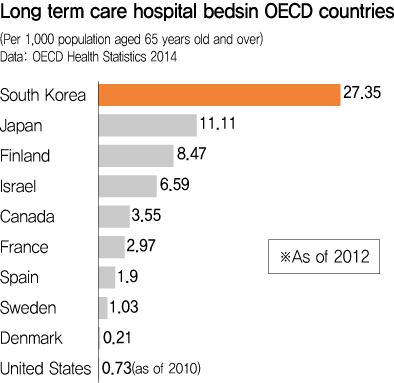 |
Rising prevalence of nursing hospitals comes from government’s failed efforts at long-term care
By Choi Sung-jin, staff reporter South Korea has the largest number of nursing hospitals of any OECD country, recently released figures show. The number of nursing hospitals in the country has surged over the past 10 years, reaching 1,284 by the end of April. While the amount of national health insurance payments made to nursing hospitals has increased accordingly, many critics find fault with the fact that there is virtually no governmental oversight or management of these facilities. According to the OECD’s 2014 Health Statistics, South Korea’s nursing hospital capacity (calculated as the number of beds per 1,000 elderly people, or those over 65 years old) was 27.35 in 2012, giving South Korea a clear lead among the 34 OECD member countries. Next after South Korea was Japan (11.11 beds) and Finland (8.47 beds), less than half and one third of South Korea’s capacity, respectively. Since 2008 (17.03), South Korea has steadily increased the number of beds at nursing homes, with 20.69 in 2009, 23.92 in 2010, and 23.92 in 2011, while Japan and Finland continued to decrease nursing home capacity over the same period. The reason that South Korea has the highest nursing home capacity in the world -despite the short history of nursing homes in the country - can paradoxically be attributed to the government’s failed policy for long-term care for the elderly. Currently, South Korea’s medical institutions that care for the elderly are generally divided into nursing hospitals and nursing institutions. Nursing hospitals are where patients who need the attention of doctors are hospitalized for a certain period of time; nursing institutions (often known as nursing homes) are less focused on providing medical service than on taking care of those institutionalized there. The problem is that even old people who do not need to see a doctor are visiting nursing hospitals. They do this because national health insurance covers the cost of their stay. “The government was originally trying to create a kind of care delivery system by assigning medical service to nursing hospitals and general care to nursing institutions. However, the nursing hospitals, which are relatively free of government regulations, have launched an aggressive marketing campaign to older patients that has completely turned this system on its head. The current number of nursing hospitals is far in excess of social demand, and consequently they are serving to waste government funds,” said Seok Jae-eun, professor of social welfare at Hallym University. While the shadow cast by the rapid increase in nursing hospitals is gradually growing, the Ministry of Health and Welfare, which is responsible for overseeing and regulating such facilities, has virtually left them to their own devices. One good example was when the government instructed new nursing hospitals to install sprinklers after a fire broke out at a nursing hospital in Jangseong, South Jeolla province in May. Even though there are already more than 1,000 nursing hospitals in the country, no measures were taken to force currently operating nursing hospitals to take fire prevention measures. “Each time that the review board for nursing hospitals meets, we ask officials from the Ministry of Health and Welfare and the Korea Institute for Healthcare Accreditation to take appropriate administrative or legal measures against nursing hospitals that are not abiding by standards about having doctors on duty. But the Ministry usually replies that it is not one hospital but nearly every hospital that is in that condition and asks how it could just punish one specific hospital. The ministry is not carrying out its role of managing and overseeing poorly run nursing hospitals; rather, it is adopting a pragmatic stance that legitimizes such practices,” said Hyun Jeong-hee, head of the Health Right Network. Hyun is a member of the nursing hospital accreditation review board at the Korea Institute for Healthcare Accreditation, which is affiliated with the Ministry of Health and Welfare. “Even before the fire at the nursing hospital in Jangseong, South Jeolla Province, we had already deliberated with the local governments in question and had them order certain nursing hospitals that were not abiding by the standards for having doctors on duty to correct those practices. We are currently considering the option of increasing the requirements for having doctors on duty at nursing hospitals,” a representative for the Ministry of Health and Welfare said. Please direct questions or comments to [english@hani.co.kr]
http://english.hani.co.kr/arti/english_edition/e_national/646365.html






 100 days later, Sewol families still pleading for the truth
100 days later, Sewol families still pleading for the truth
